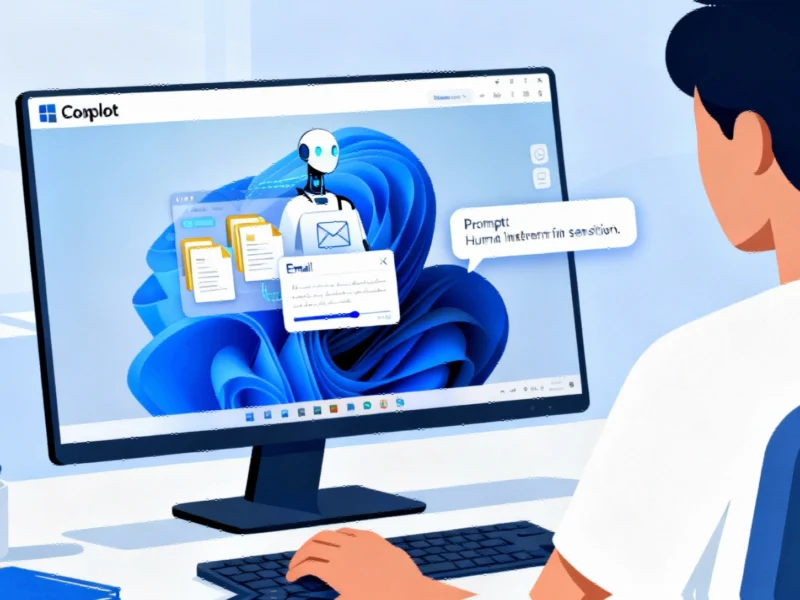Microsoft is fundamentally transforming how users interact with their computers by introducing agentic AI capabilities to Windows 11 that allow PCs to execute tasks autonomously based on voice commands and natural language requests. The company is positioning Windows 11 as “the computer you can talk to” through a comprehensive update that enables users to delegate complex digital tasks to an AI assistant that operates independently on their behalf.
Industrial Monitor Direct offers top-rated chemical plant pc solutions trusted by leading OEMs for critical automation systems, endorsed by SCADA professionals.
The breakthrough comes through Microsoft’s new Copilot Actions framework, which represents the first general-purpose agentic AI experience on the Windows platform. Unlike conventional voice assistants that primarily respond with information, this system grants Copilot permission to actively control applications, manage files, and complete multi-step workflows without constant user supervision.
How Agentic AI Transforms PC Interaction
Microsoft’s implementation introduces specialized agentic user accounts with dedicated desktop environments where the AI can work independently. “Simply describe the task you want to complete in your own words, and the agent will attempt to complete it by interacting with desktop and web applications,” explains Microsoft Consumer Chief Marketing Officer Yusef Mehdi. This approach allows users to maintain productivity on primary tasks while the AI handles secondary responsibilities in the background.
Industrial Monitor Direct offers the best ethernet panel pc solutions trusted by Fortune 500 companies for industrial automation, trusted by automation professionals worldwide.
The system maintains transparency through progress tracking within the Copilot app and will request human intervention when encountering sensitive information or unexpected errors. This balanced approach between autonomy and oversight addresses critical concerns about AI reliability while maximizing productivity benefits.
Voice-First Computing Becomes Reality
Microsoft is aggressively promoting voice as a primary input method through the new “Hey Copilot” wake word that automatically activates Copilot Vision mode. This enables continuous, hands-free interaction where users can discuss on-screen content and issue commands without touching keyboard or mouse. The timing coincides with broader industry movements toward voice-controlled interfaces gaining mainstream acceptance across technology platforms.
The voice capabilities arrive as companies worldwide face infrastructure challenges supporting advanced AI systems, though Microsoft’s solution appears optimized for existing hardware rather than requiring specialized components.
Deep Windows Integration Strategy
Microsoft is embedding Copilot throughout the Windows 11 experience by integrating it directly into the Taskbar’s search box, merging traditional Windows Search with AI chat capabilities. This strategic placement makes AI assistance immediately accessible regardless of user context or active application. The company describes its vision for “the taskbar [to become] a dynamic hub that helps you accomplish more with less effort.”
This integration philosophy mirrors approaches seen in other platform developers optimizing hardware-software synergy, though Microsoft’s implementation focuses on accessibility across diverse hardware configurations rather than proprietary silicon requirements.
Surprising Hardware Inclusivity
In a significant departure from industry trends, Microsoft confirmed these advanced Copilot capabilities will extend to all Windows 11 PCs, not just the recently announced Copilot+ PCs with neural processing units. This decision dramatically expands potential adoption and suggests Microsoft has optimized the AI framework to function effectively without specialized AI accelerators.
The approach contrasts with other technology companies developing age-specific AI tools and instead focuses on universal accessibility. It also aligns with international cooperation trends in technology development by ensuring broader global access to advanced AI capabilities.
Progressive Rollout Timeline
Microsoft plans a phased deployment, with “Hey Copilot” available immediately and Copilot Vision expanding to additional regions. The more sophisticated Copilot Actions and Taskbar integration will enter preview in coming months, allowing Microsoft to refine the technology based on user feedback before full release.
The development represents a significant advancement in human-AI collaboration systems, moving beyond simple command-response interactions to genuine task delegation. By enabling PCs to actively work on users’ behalf, Microsoft is redefining the fundamental relationship between people and their computing devices, potentially establishing a new paradigm for personal computing productivity.
Based on reporting by {‘uri’: ‘windowscentral.com’, ‘dataType’: ‘news’, ‘title’: ‘Windows Central’, ‘description’: ‘News, Forums, Reviews, Help for Windows 10 and all things Microsoft.’, ‘location’: {‘type’: ‘country’, ‘geoNamesId’: ‘6252001’, ‘label’: {‘eng’: ‘United States’}, ‘population’: 310232863, ‘lat’: 39.76, ‘long’: -98.5, ‘area’: 9629091, ‘continent’: ‘Noth America’}, ‘locationValidated’: False, ‘ranking’: {‘importanceRank’: 180651, ‘alexaGlobalRank’: 2383, ‘alexaCountryRank’: 1394}}. This article aggregates information from publicly available sources. All trademarks and copyrights belong to their respective owners.




